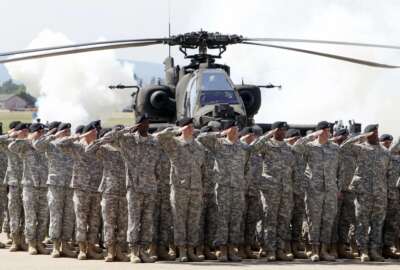Hubbard Radio Washington DC, LLC. All rights reserved. This website is not intended for users located within the European Economic Area.
Army’s 2023 budget will remain relatively flat, temporarily shrink end strength
The Army is stressing continuity in its 2023 budget request by keeping its eye on modernization efforts and asking for a relatively flat budget of $178 billion. However, in order to ensure it has the quality of soldiers it needs for future warfare, the service will temporarily drop its end strength by 12,000 soldiers.
“The Army is undergoing a transformation to one of the Army of 2030 and beyond,” said Army Undersecretary Gabriel Camarillo in...
The Army is stressing continuity in its 2023 budget request by keeping its eye on modernization efforts and asking for a relatively flat budget of $178 billion. However, in order to ensure it has the quality of soldiers it needs for future warfare, the service will temporarily drop its end strength by 12,000 soldiers.
“The Army is undergoing a transformation to one of the Army of 2030 and beyond,” said Army Undersecretary Gabriel Camarillo in a roundtable with reporters. “It is transitioning out of two decades of support for counterterrorism operations into an Army that is postured as part of the joint force to meet the demands of what the pacing challenges are of China and certainly of obviously the acute threat posed by Russian aggression.”
Camarillo said the continuation from 2022 to 2023 includes investments in next generation capabilities and technologies that emphasize the joint force. The Army will keep investing in things like hypersonics, mid-range capabilities and precision fires.
The total budget is only about $3 billion more than the previous year’s request. However, what goes on underneath the topline will continue to build the capabilities of the Army.
The Army wants to make sure it as the right people in place when its modernization efforts come to fruition, it is therefore dropping end strength from 485,000 in 2021 to 473,000 in 2023.
“We want to make sure that we are maintaining our emphasis on high quality talent, and we are looking at making sure that we fill the needs of a cutting edge Army through things like our Multi Domain Task Force, and we’re enabling them to use the equipment that we’re developing into the future,” Camarillo said. “This is not a budget driven decision. It is entirely about quality, and we will look to build back up are entering over the future years defense plan.”
The Army will slow its recruitment rate in 2023 in order to realize that plan. That decision also comes at a time when recruitment is hard for the military services as businesses are vying for the labor force and people are still wary about working during the pandemic.
The largest increases in the Army budget coming in personnel, at 5%, and operations and maintenance at 5.5%.
Most other accounts will take a cut, procurement and research will drop about 6% and the military construction account will decrease by 39%.
The Army says that rate adjustments and more mobilized reservists account for the increase in personnel funding. Officials also noted they are spending less on O&M because of the draw down in combat operations.
Procurement and research decreases are attributed to a less need for replenishing ammunition.
The 39% drop in military construction is a drop from $2.2 billion enacted level this year to $1.8 billion in 2023.
The 2022 spending omnibus gave the Army 11% more than it requested in facilities sustainment and restoration funds to take care of buildings are other facilities in need of repair.
Army officials said that they lock in the topline number before the invasion of Ukraine and before inflation rates were at the levels they are today.
However, the budget officials said the administration is employing some additional resources to hedge the effects of inflation. They said the budget as it is still buffers against inflation, while still creating real growth within the Army.
As far as individual programs go, the Army will request 35 Apache helicopters and 25 Blackhawks.
It is also important to note that the budget is only a suggestion from the administration on what it feels the Army needs.
Congress ultimately holds the purse strings and it made that very clear in the 2022 budget. The spending bill ended up giving the military $30 billion more than it asked for in the President’s request.
Last week, 40 Republican lawmakers signed a letter stating that they think the 2023 military budget should be 5% higher than adjustments for inflation.
Scott Maucione
Scott Maucione is a defense reporter for Federal News Network and reports on human capital, workforce and the Defense Department at-large.
Follow @smaucioneWFED






